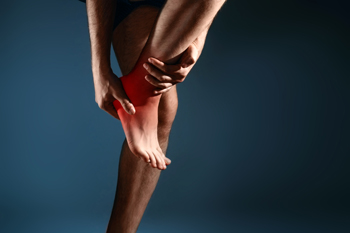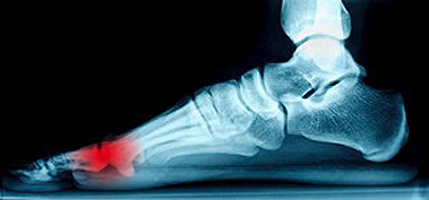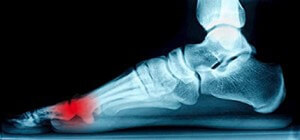vendor
Identifying What Your Heel Pain Means
 Heel pain is usually felt under the heel or behind it. There are various conditions that can cause heel pain, and the location of the pain is indicative of what the specific condition could be. One common cause of heel pain is plantar fasciitis, which is inflammation of the plantar fascia-tissue that runs from the heel bone to the ball of the foot. Plantar fasciitis is usually caused by either high or low arches. Sever’s disease only affects children, usually between the ages of 7 and 15 years old, and is caused by overuse of the growth plates in the heel bone. This condition typically affects children that play sports because of the repetitive impact that the foot endures. These are just two of the many possible conditions that cause heel pain. If you have regular heel pain, it is strongly recommended you speak with a podiatrist to learn about the condition and receive the proper treatment.
Heel pain is usually felt under the heel or behind it. There are various conditions that can cause heel pain, and the location of the pain is indicative of what the specific condition could be. One common cause of heel pain is plantar fasciitis, which is inflammation of the plantar fascia-tissue that runs from the heel bone to the ball of the foot. Plantar fasciitis is usually caused by either high or low arches. Sever’s disease only affects children, usually between the ages of 7 and 15 years old, and is caused by overuse of the growth plates in the heel bone. This condition typically affects children that play sports because of the repetitive impact that the foot endures. These are just two of the many possible conditions that cause heel pain. If you have regular heel pain, it is strongly recommended you speak with a podiatrist to learn about the condition and receive the proper treatment.
Many people suffer from bouts of heel pain. For more information, contact one of our podiatrists of Podiatry Associates of Texas. Our doctors can provide the care you need to keep you pain-free and on your feet.
Causes of Heel Pain
Heel pain is often associated with plantar fasciitis. The plantar fascia is a band of tissues that extends along the bottom of the foot. A rip or tear in this ligament can cause inflammation of the tissue.
Achilles tendonitis is another cause of heel pain. Inflammation of the Achilles tendon will cause pain from fractures and muscle tearing. Lack of flexibility is also another symptom.
Heel spurs are another cause of pain. When the tissues of the plantar fascia undergo a great deal of stress, it can lead to ligament separation from the heel bone, causing heel spurs.
Why Might Heel Pain Occur?
- Wearing ill-fitting shoes
- Wearing non-supportive shoes
- Weight change
- Excessive running
Treatments
Heel pain should be treated as soon as possible for immediate results. Keeping your feet in a stress-free environment will help. If you suffer from Achilles tendonitis or plantar fasciitis, applying ice will reduce the swelling. Stretching before an exercise like running will help the muscles. Using all these tips will help make heel pain a condition of the past.
If you have any questions please contact our offices located in Arlington and Weatherford, TX . We offer the newest diagnostic and treatment technologies for all your foot and ankle needs.
Causes, Symptoms, and Treatment for a Broken Foot
One out of ten broken bones is reported to be in the feet. When an object crushes, bends, or stretches the bone beyond acceptable ranges, bones break. A break in the foot is either a fracture or a straight break.
The location of any break can tell you how the break happened. Toes, for instance, break typically as a result of something being kicked hard and with great force. Heel breaks almost always are a result of an improper landing from a tall height. Twists or sprains are the other two frequent occurrences. As with all usual breaks, they result from unexpected accident or sudden injury. As with stress fractures, breaks form as a process over time from repeated stress on already present cracks. Runners, dancers, and gymnasts are the usual athletes who receive this type of break. Stress fractures result from incredible pressure on the feet. It is no surprise these athletes bear the majority of reported fractures.
Pain, swelling, bruising, and redness are all indicative of the typical symptoms from a broken foot. Severe pain—to the point of not being able to walk—usually depends on the location of the break in the foot. Toes are on the lower scale of pain threshold, but heels are high, as are a few other particular bones. As the severity of the broken foot increases, symptoms like blueness, numbness, misshaping of the foot, cuts, or deformities will become apparent. These symptoms indicate the need to see a medical professional with access to an x-ray facility.
Prior to seeing a specialist, precautions should be taken to reduce pain and swelling. Elevate and stabilize the foot, and refrain from moving it. Immobilization of the foot is the next priority, so creating a homemade splint is acceptable. Keep in mind that while creating a splint, any increase of pain or cutting off blood circulation means that the splint should be removed immediately. Use ice to decrease swelling and relieve pain symptoms.
When dealing with a medical center, the patient should note that the treatment can vary. The treatment will depend on the severity of the fracture and the cause of the break. Crutches, splits, or casts are common treatments while surgery has been known to be used in more severe cases in order to repair the break in the bones.
What are Achilles Tendon Injuries
The Achilles tendon is the strongest tendon in the human body. Its purpose is to connect the lower leg muscles and calf to the heel of the foot. This tendon is responsible for facilitating all types of movement, like walking and running. This tendon provides an enormous amount of mobility for the body. Any injuries inflicted to this tissue should be immediately brought up with a physician to prevent further damage.
The most common injuries that can trouble the Achilles tendon are tendon ruptures and Achilles tendinitis. Achilles tendinitis is the milder of the two injuries. It can be recognized by the following symptoms: inflammation, dull to severe pain, an increased flow of blood to the tendon, thickening of the tendon, and slower movement time. Tendinitis can be treated via several methods and is often diagnosed by an MRI.
An Achilles tendon rupture is trickier to heal, and is by far the most painful injury. It is caused by the tendon ripping or completely snapping. The results are immediate and absolutely devastating, and will render the patient immobile. If a rupture or tear occurs, operative and non-operative methods are available. Once the treatment begins, depending on the severity of the injury, recovery time for these types of issues can take up to a year.
Simple preventative measures can be taken as a means to avoid both injuries. Prior to any movement, taking a few minutes to stretch out the tendon is a great way to stimulate the tissue. Calf raises, squats, leg curls, leg extensions, leg raises, lunges, and leg presses are all suggested ways to help strengthen the lower legs and promote Achilles tendon health.
Many problems arise among athletes and people who overexert themselves while exercising. Problems can also happen among those who do not properly warm up before beginning an activity. Proper, comfortable shoes that fit correctly can also decrease tendon injuries. Some professionals also suggest that when exercising, you should make sure that the floor you are on is cushioned or has a mat. This will relieve pressure on the heels. A healthy diet will also increase tendon health.
It is very important to seek out a podiatrist if you believe you have an injury in the Achilles region. Further damage could result in severe complications that would make being mobile difficult, if not impossible.
Stretches That Can Help Sever’s Disease
 Sever’s disease is a painful heel condition that only affects children. Swelling of the growth plate is what causes this disease, along with discomfort and pain. Children that are involved in sports are more likely to have this affiliation, because injuries to the growth plate are caused by weight-bearing activities. Stretching can help to prevent Sever’s disease, and it can also assist in the healing process. Movements that stretch the hamstring, calf muscles, and tendons on the back of the leg should be performed 2 to 3 times a day, with the stretch being held for around 20 seconds. Even if there is only pain in one heel, the stretches should be done with both legs. Exercises that strengthen the muscles surrounding the shin will also help alleviate some discomfort and help to prevent this condition from developing again. If you think your child may have Sever’s Disease, then it is highly recommended to consult with a podiatrist in order to receive more information and proper treatment.
Sever’s disease is a painful heel condition that only affects children. Swelling of the growth plate is what causes this disease, along with discomfort and pain. Children that are involved in sports are more likely to have this affiliation, because injuries to the growth plate are caused by weight-bearing activities. Stretching can help to prevent Sever’s disease, and it can also assist in the healing process. Movements that stretch the hamstring, calf muscles, and tendons on the back of the leg should be performed 2 to 3 times a day, with the stretch being held for around 20 seconds. Even if there is only pain in one heel, the stretches should be done with both legs. Exercises that strengthen the muscles surrounding the shin will also help alleviate some discomfort and help to prevent this condition from developing again. If you think your child may have Sever’s Disease, then it is highly recommended to consult with a podiatrist in order to receive more information and proper treatment.
Sever's disease often occurs in children and teens. If your child is experiencing foot or ankle pain, see one of our podiatrists from Podiatry Associates of Texas. Our doctors can treat your child’s foot and ankle needs.
Sever’s Disease
Sever’s disease is also known as calcaneal apophysitis, which is a medical condition that causes heel pain I none or both feet. The disease is known to affect children between the ages of 8 and 14.
Sever’s disease occurs when part of the child’s heel known as the growth plate (calcaneal epiphysis) is attached to the Achilles tendon. This area can suffer injury when the muscles and tendons of the growing foot do not keep pace with bone growth. Therefore, the constant pain which one experiences at the back of the heel will make the child unable to put any weight on the heel. The child is then forced to walk on their toes.
Symptoms
Acute pain – Pain associated with Sever’s disease is usually felt in the heel when the child engages in physical activity such as walking, jumping and or running.
Highly active – Children who are very active are among the most susceptible in experiencing Sever’s disease, because of the stress and tension placed on their feet.
If you have any questions, please feel free to contact our offices located in Arlington and Weatherford, TX . We offer the newest diagnostic and treatment technologies for all your foot and ankle injuries.
Identifying Sesamoiditis
 Sesamoiditis mostly affects young adults who engage in physical activities like running or dancing. It is a condition that affects the forefoot and the most common symptom is discomfort or pain under the big toe joint. Sesamoid bones are tiny bones within tendons that connect to the big toe, and sesamoiditis is a result of them being irritated. The tendons around the bones will also become inflamed, having similar effects to conditions like tendinitis. The onset of sesamoiditis is gradual, the pain usually begins as a minor ache, but after continuous activity the sesamoids become more aggravated. The mild ache will eventually turn into a throbbing pain that will be hard to ignore. In most cases of sesamoiditis, resting the foot will help alleviate painful symptoms. If you give your foot a break from physical activity and the pain persists, then it is highly recommended you make an appointment with a podiatrist to learn about treatment options.
Sesamoiditis mostly affects young adults who engage in physical activities like running or dancing. It is a condition that affects the forefoot and the most common symptom is discomfort or pain under the big toe joint. Sesamoid bones are tiny bones within tendons that connect to the big toe, and sesamoiditis is a result of them being irritated. The tendons around the bones will also become inflamed, having similar effects to conditions like tendinitis. The onset of sesamoiditis is gradual, the pain usually begins as a minor ache, but after continuous activity the sesamoids become more aggravated. The mild ache will eventually turn into a throbbing pain that will be hard to ignore. In most cases of sesamoiditis, resting the foot will help alleviate painful symptoms. If you give your foot a break from physical activity and the pain persists, then it is highly recommended you make an appointment with a podiatrist to learn about treatment options.
Sesamoiditis is an unpleasant foot condition characterized by pain in the balls of the feet. If you think you’re struggling with sesamoiditis, contact one of our podiatrists of Podiatry Associates of Texas. Our doctors will treat your condition thoroughly and effectively.
Sesamoiditis
Sesamoiditis is a condition of the foot that affects the ball of the foot. It is more common in younger people than it is in older people. It can also occur with people who have begun a new exercise program, since their bodies are adjusting to the new physical regimen. Pain may also be caused by the inflammation of tendons surrounding the bones. It is important to seek treatment in its early stages because if you ignore the pain, this condition can lead to more serious problems such as severe irritation and bone fractures.
Causes of Sesamoiditis
- Sudden increase in activity
- Increase in physically strenuous movement without a proper warm up or build up
- Foot structure: those who have smaller, bonier feet or those with a high arch may be more susceptible
Treatment for sesamoiditis is non-invasive and simple. Doctors may recommend a strict rest period where the patient forgoes most physical activity. This will help give the patient time to heal their feet through limited activity. For serious cases, it is best to speak with your doctor to determine a treatment option that will help your specific needs.
If you have any questions please feel free to contact our offices located in Arlington and Weatherford, TX . We offer the newest diagnostic and treatment technologies for all your foot and ankle needs.
Swollen Feet and Pregnancy
 A typical symptom that many pregnant women may notice is swollen feet. This may generally occur during the second and third trimester, and can be uncomfortable. This may be a result of a thickened blood flow, in addition to the growing fetus, uterus, and placenta. There may be several reasons why discomfort may be experienced, including standing or sitting for extended periods of time, exposure to heat during the summer months, improper sodium intake, or carrying more than one baby. Moderate relief may be found by elevating the feet frequently during the day, limiting caffeine and sodium intake, wearing comfortable shoes, and drinking plenty of fresh water daily. If the feet should suddenly appear swollen, it may be indicative of medical conditions that may be present. If you feel any pain in your feet, it is suggested to speak to a podiatrist who can properly determine the cause.
A typical symptom that many pregnant women may notice is swollen feet. This may generally occur during the second and third trimester, and can be uncomfortable. This may be a result of a thickened blood flow, in addition to the growing fetus, uterus, and placenta. There may be several reasons why discomfort may be experienced, including standing or sitting for extended periods of time, exposure to heat during the summer months, improper sodium intake, or carrying more than one baby. Moderate relief may be found by elevating the feet frequently during the day, limiting caffeine and sodium intake, wearing comfortable shoes, and drinking plenty of fresh water daily. If the feet should suddenly appear swollen, it may be indicative of medical conditions that may be present. If you feel any pain in your feet, it is suggested to speak to a podiatrist who can properly determine the cause.
Pregnant women with swollen feet can be treated with a variety of different methods that are readily available. For more information about other cures for swollen feet during pregnancy, consult with one of our podiatrists from Podiatry Associates of Texas. Our doctors will attend to all of your foot and ankle needs.
What Foot Problems Can Arise During Pregnancy?
One problem that can occur is overpronation, which occurs when the arch of the foot flattens and tends to roll inward. This can cause pain and discomfort in your heels while you’re walking or even just standing up, trying to support your baby.
Another problem is edema, or swelling in the extremities. This often affects the feet during pregnancy but tends to occur in the later stages.
How Can I Keep My Feet Healthy During Pregnancy?
- Wearing orthotics can provide extra support for the feet and help distribute weight evenly
- Minimize the amount of time spent walking barefoot
- Wear shoes with good arch support
- Wear shoes that allow for good circulation to the feet
- Elevate feet if you experience swelling
- Massage your feet
- Get regular, light exercise, such as walking, to promote blood circulation to the feet
If you have any questions please feel free to contact our offices located in Arlington and Weatherford, TX . We offer the newest diagnostic and treatment technologies for all your foot and ankle needs.
Pregnancy and Foot Health
Many pregnant women complain about foot pain while they are expecting. Foot pain can primarily be caused by weight gain and hormonal changes taking place in the body. By understanding how pregnancy impacts the health of a woman's feet, a pregnant woman can take action to keep her feet as healthy and comfortable as possible.
Because a woman's weight changes during pregnancy, more pressure is brought to bear on both the legs and the feet. This weight shift can cause two major foot problems: over-pronation, also known as flat feet, as well as edema, which is swelling of the feet. Over-pronation occurs when the arch of the foot flattens, causing the foot to roll inwards when the individual is walking, and can aggravate the plantar fascia tissues located along the bottom of the feet. If these tissues become inflamed, a pregnant woman can experience pain in the heel of the foot as well as severe foot pain while walking or standing. Swelling of the feet, or edema, often occurs in the later stages of pregnancy. It is caused by slow circulation and water retention, and may turn the feet a light purple color.
To keep feet in good health and prevent over-pronation, pregnant women should avoid walking barefoot and be sure they are wearing shoes that offer good arch support. A device known as an orthotic can be added to regular footwear in order to provide additional support for the feet during pregnancy. Any expectant mother whose feet hurt should first check to see if the shoes she is wearing are old, worn out and not offering the proper support necessary for distributing the weight of her body during pregnancy.
To treat edema of the feet, a good start is to wear quality footwear which offers support and good circulation. Keep feet elevated whenever possible by using a foot stool while seated. Stay well hydrated by drinking plenty of water to prevent water retention in the feet. Any swelling that occurs in only one foot should be examined as soon as possible by a doctor.
Good foot health during pregnancy can help expectant mothers avoid foot pain that leads to other health problems. Massaging the feet and doing regular gentle exercise like walking aids foot health by contributing to good circulation. Supportive shoes are also a good investment that will support foot health during pregnancy.






